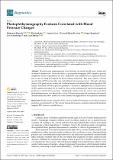Photoplethysmography Features Correlated with Blood Pressure Changes
Author(s)
Elgendi, Mohamed; Jost, Elisabeth; Alian, Aymen; Fletcher, Richard Ribon; Bomberg, Hagen; Eichenberger, Urs; Menon, Carlo; ... Show more Show less
Downloaddiagnostics-14-02309.pdf (1.353Mb)
Publisher with Creative Commons License
Publisher with Creative Commons License
Creative Commons Attribution
Terms of use
Metadata
Show full item recordAbstract
Blood pressure measurement is a key indicator of vascular health and a routine part of medical examinations. Given the ability of photoplethysmography (PPG) signals to provide insights into the microvascular bed and their compatibility with wearable devices, significant research has focused on using PPG signals for blood pressure estimation. This study aimed to identify specific clinical PPG features that vary with different blood pressure levels. Through a literature review of 297 publications, we selected 16 relevant studies and identified key time-dependent PPG features associated with blood pressure prediction. Our analysis highlighted the second derivative of PPG signals, particularly the 𝑏/𝑎
and 𝑑/𝑎
ratios, as the most frequently reported and significant predictors of systolic blood pressure. Additionally, features from the velocity and acceleration photoplethysmograms were also notable. In total, 29 features were analyzed, revealing novel temporal domain features that show promise for further research and application in blood pressure estimation.
Date issued
2024-10-17Department
Massachusetts Institute of Technology. Department of Mechanical EngineeringJournal
diagnostics
Publisher
Multidisciplinary Digital Publishing Institute
Citation
Elgendi, M.; Jost, E.; Alian, A.; Fletcher, R.R.; Bomberg, H.; Eichenberger, U.; Menon, C. Photoplethysmography Features Correlated with Blood Pressure Changes. Diagnostics 2024, 14, 2309.
Version: Final published version